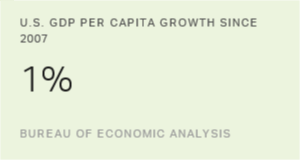PRINCETON, NJ -- Gallup's underemployment measure hit 20.0% on March 15 -- up from 19.7% two weeks earlier and 19.5% at the start of the year. Gallup Daily tracking makes it possible to monitor the underemployment rate throughout the month, rather than just once per month, making it the best and most timely way to measure the U.S. jobs situation.

The findings underscore why Americans say the most important problem facing the nation today is jobs and unemployment. Gallup's underemployment measure is based on more than 20,000 phone interviews collected over a 30-day period and reported daily. Gallup's results are not seasonally adjusted and tend to be a precursor of government reports by approximately two weeks.
More Part-Time Employees Seeking Full-Time Work
Gallup classifies Americans as underemployed if they are unemployed or working part-time but wanting full-time work. On March 15, Gallup's unemployment rate was 10.3% -- essentially the same as the 10.4% of March 1, but down from 10.8% in mid-February. However, this decline in the percentage of unemployed Americans was more than offset over the past 30 days by an increase in the percentage of those working part-time but wanting full-time work, from 9.0% in mid-February to 9.7% in mid-March.

Gallup's data suggest that while the U.S. unemployment rate has declined over the past month, the employment gains may be largely taking the form of new part-time jobs. Many of those acquiring these new jobs may be Americans who find that, although they would prefer to be working full-time, only part-time work is available.
Focus on Underemployment, Not Unemployment
Even with historic healthcare legislation under consideration, Congress passed and the president signed a new jobs creation bill on March 18. No doubt, national attention will shortly shift to unemployment and anticipation of the government's April 2 report of the March unemployment rate. In this regard, Gallup's mid-March unemployment rate is likely indicative of the not-seasonally adjusted unemployment rate the government will release in April, as is Gallup's broader underemployment rate.
The danger associated with focusing on unemployment is reflected by the recent statement of Morgan Stanley economists suggesting that the U.S. may add as many as 300,000 jobs in March owing to an improvement in the weather, economic growth, and the government's hiring of temporary census workers. If anything close to this number of new jobs is announced by the government in early April, there is likely to be an enthusiastic, possibly even celebratory, response. Government officials are liable to tout the continued benefits of last year's stimulus and the future benefits of the new jobs bill. Many Wall Streeters will likely argue that the surge in jobs is simply another confirmation of the strength of the overall economic recovery.
However, before policymakers celebrate too much, they should note Gallup's recent findings involving its new, more inclusive measure of underemployment. To be sure, there are some benefits associated with the unemployed getting part-time jobs, no matter the source. For example, Gallup's self-reported spending data show that part-time workers who want full-time work spent on average 24% more per day ($51) during the past 30 days than did the unemployed ($41). While this represents an improvement and is good for the economy, it is not nearly as good as the 85% higher daily spending of those having full-time jobs ($76).
It is also often suggested that a growth in part-time jobs may indicate future growth in full-time work -- that companies hire part-time workers before committing to hiring new full-time employees. While this is sometimes the case, it may not be so at this point in the U.S. economy: Gallup data show that one in three part-time employees who are wanting full-time work are currently "hopeful" about finding a full-time job in the next 30 days -- not much of an endorsement of the idea that today's new part-time work will progress to full-time jobs.
Regardless of how one interprets the shifts taking place between part-time and full-time jobs, it is important that policymakers focus on the broader goal of reducing underemployment, not just unemployment. Part-time, temporary jobs like those associated with census-taking are far better than no job and may reduce the unemployment rate, but they do not represent the kind of job creation needed for a sustainable economic recovery.
Review and export the complete daily trends on these measures: Workforce; Economic Indexes; Consumer Spending; Economic Outlook; Economic Conditions; Job Market
Learn more about Gallup's economic measures.
Survey MethodsFor Gallup Daily tracking, Gallup interviews approximately 1,000 national adults, aged 18 and older, each day. Gallup's employment metrics are based on nightly interviews with approximately 675 national adults who are part of the workforce. Results reported each day are based on a 30-day rolling average, aggregated from telephone interviews with approximately 20,000 adults. For these results, one can say with 95% confidence that the maximum margin of sampling error is ±1 percentage point.
Interviews are conducted with respondents on land-line telephones and cellular phones.
In addition to sampling error, question wording and practical difficulties in conducting surveys can introduce error or bias into the findings of public opinion polls.
